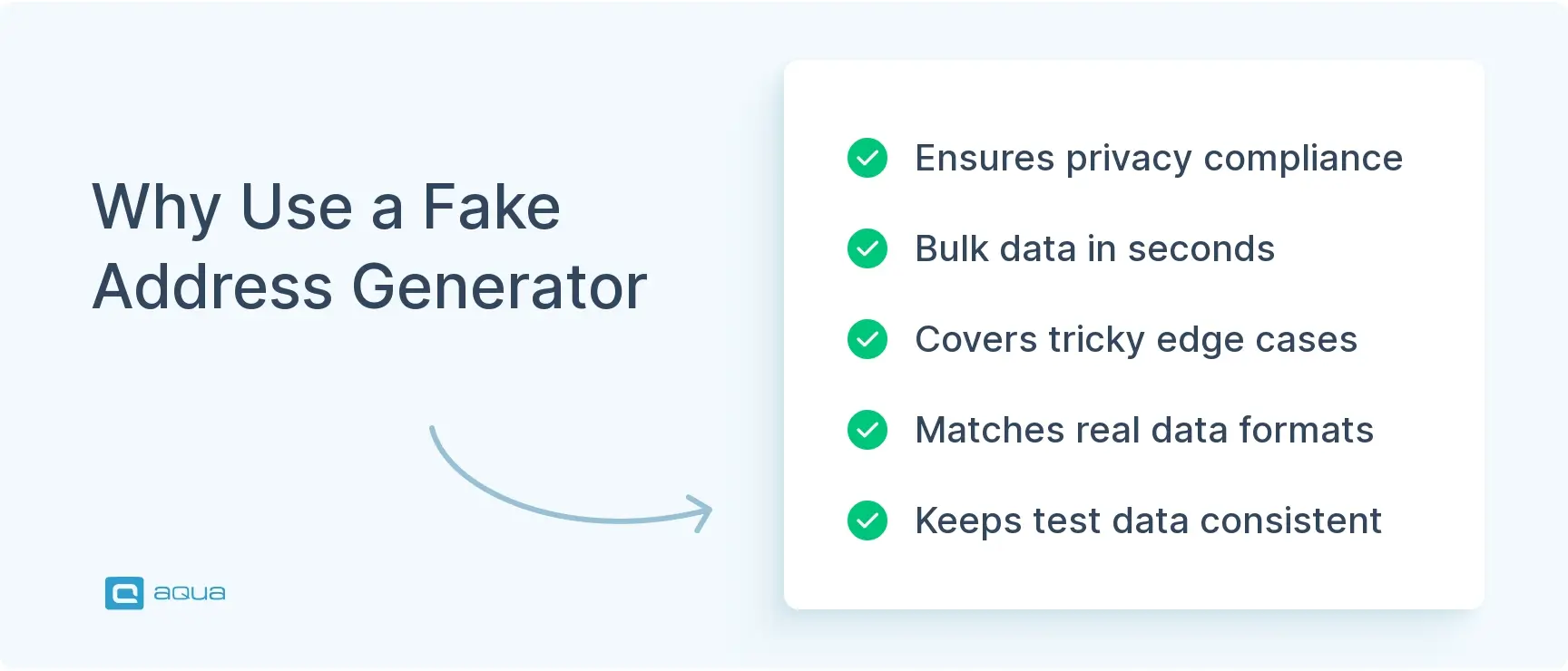This tool generates fake, random addresses for testing purposes. These are not real addresses and should not be used for actual mail delivery or any official purposes. You can generate up to 50 addresses at once.
When testing requires realistic data without privacy risks, you need more than just a random generator. aqua cloud is a dedicated test and requirement management platform with AI-powered test data generation capabilities. Unlike basic solutions available on the market, aqua’s domain-trained AI Copilot can instantly create unlimited context-aware test data across multiple languages, saving you hours of manual setup work. The platform securely manages your test data across different environments while maintaining full traceability through comprehensive audit logging. With aqua, you get an end-to-end solution that protects privacy and ensures compliance. What’s also great about aqua is that it integrates with your existing tools like Jira and Jenkins, through REST API support.
100% test coverage with aqua's AI-powered platform
What is a Random Address Generator?
A random address generator creates synthetic postal addresses on demand. These aren’t pulled from phone books or leaked databases. They’re algorithmically assembled from components like street patterns, real city names, and postal code formats. The result? Addresses that pass basic validation checks and look completely authentic but don’t point to anyone’s actual home.
Most generators let you pick a country or locale, then produce addresses formatted correctly for that region. An address generator for America might give you “742 Evergreen Terrace, Springfield, IL 62701.” A UK version could produce “15 Ashford Lane, Manchester M1 4BT.” The detail matters: proper postal codes, realistic street types, and appropriate city-state pairings.
If you need to create fake addresses for testing purposes, many online tools can help you generate realistic-looking information instantly. An address randomizer ensures your test data looks authentic without compromising anyone’s privacy.
Why Use an Address Generator?
Using production data in test environments creates compliance nightmares. GDPR, CCPA, and similar privacy laws restrict processing real user data outside its original purpose. “We need test data” doesn’t cut it as a legal basis. Fake address generators solve this by providing realistic test data that’s completely separate from actual people. There’s no PII to expose because the data never belonged to anyone.
These tools make life easier. Manual data entry is slow and error-prone. A good address generator covers edge cases automatically and gives you variety and volume at the click of a button. Generators produce bulk data in seconds. You can script them into your CI/CD pipeline, automatically seeding fresh test databases on every build.
- Privacy compliance: No risk of exposing real user data in non-production environments
- Speed: Generate hundreds or thousands of addresses in seconds, not hours
- Edge-case coverage: Automatically includes tricky formats, special characters, and international variations
- Realistic validation: Data mirrors real-world patterns, so your tests actually mean something
- Consistency and repeatability: Enterprise platforms maintain referential integrity across multiple tables, so fake users have matching billing, shipping, and contact addresses

How Does a Random Address Generator Work?
Most address randomizer tools use a mix of templates, dictionaries, and randomization algorithms. The process happens in-memory or via API, outputting fresh, disposable addresses each time.
How the generation process works step by step:
- Select locale/country: Choose a country or region, which determines format rules, postal code patterns, and naming conventions
- Generate street number: The tool randomly picks a number, typically between 1 and 9999
- Select street name: It pulls from a dictionary of common street names like “Maple” or “Oak”
- Add street type: The generator appends a street type such as “Street” or “Avenue”
- Match city and postal code: The tool pairs the address with a city-state-ZIP combo that’s geographically plausible. More sophisticated tools use real postal code databases to ensure zips align with cities
- Add optional components: Some generators include apartment numbers, coordinates, time zones, or region metadata for advanced use cases like testing mapping APIs
Use Cases for Fake Address Generators
Fake address generators serve multiple practical purposes across development, design, and business workflows.
Form Testing
Building a signup flow or checkout page means validating that your address fields behave correctly. A generator lets you test with hundreds of variations: multi-line addresses, international formats, PO boxes, addresses with apartment numbers. You’ll catch bugs in your validators and parsers before users do.
Database Population
Database population is another major application. When spinning up a QA or staging environment, you need realistic sample data to make tests meaningful. Seeding a user table with 10,000 fake addresses gives you the volume and variety to test search, sorting, autocomplete, and reporting features without touching production data.
Shipping and Billing Simulations
E-commerce and logistics platforms lean heavily on address generators for shipping and billing simulations. You can test how systems handle domestic versus international addresses. The American address generator is particularly useful when testing systems that need to process US-formatted addresses with the correct state abbreviations and ZIP codes. An address United States generator ensures that all generated data follows USPS formatting guidelines.
Integration Testing
Integration testing also benefits. Validating that your CRM syncs correctly with your billing system and your analytics pipeline works better when using the same pool of synthetic addresses to ensure referential integrity.
Design and Demo Work
Beyond software, address generators are handy for design and demo work. UX designers drop them into prototypes and mockups to make interfaces feel real without accidentally leaking actual user data. Sales teams use them to populate demo accounts that look legitimate during product walkthroughs.
Even game designers and fiction writers use them to quickly build out believable worlds and character backgrounds. The pattern is the same: you need data that feels authentic, but you don’t want to use the real thing. Or you legally can’t.
Limitations of Random Address Generators
These addresses are fake. You can’t ship a package to them, register them with government agencies, or use them for anything legally binding. Using a synthetic address for KYC processes, tax filings, insurance claims, or financial transactions is often unlawful.
If testing a system that requires real-world verification like a payment processor with AVS checks or a logistics platform that validates addresses against postal databases, fake data will fail. Know your use case.
Key limitations to consider:
- Not legally usable: Can’t be used for contracts, official records, or real-world delivery
- Limited customization: Web-based generators and simple libraries offer limited control over the output. If you need addresses that follow hyper-specific business rules, you might need to roll your own or invest in an enterprise synthetic data platform
- Lack of context awareness: Basic tools won’t generate addresses that logically fit a narrative, though newer AI-driven tools are starting to close that gap
- Quality versus realism trade-off: Simpler generators produce addresses that pass syntax checks but might not be geographically coherent. A ZIP code might not match the city. More advanced tools fix this but add complexity and cost
- No guarantees of geospatial accuracy: If testing a delivery route optimizer or a mapping API, you’ll need addresses with real coordinates and topological consistency. Not every tool offers that
- Risk of over-reliance: Synthetic data is great for initial testing, but real-world edge cases still require some production-like data or anonymized samples
When you need to create fake addresses for specialized testing, choose a generator that aligns with your specific requirements. The fake US address generator might work perfectly for domestic testing but fall short for international scenarios.
As privacy regulations continue to tighten, having a solid test data strategy becomes essential. aqua cloud. An AI-powered test and requirement management platform, takes your approach to QA to the next level. It as sophisticated AI-powered data generation capabilities and lots of value-adding features. With aqua, you can instantly create thousands of realistic test records that maintain referential integrity across your test scenarios while ensuring complete GDPR compliance and data security. The platform’s domain-trained AI Copilot understands your project context, producing data that’s syntactically correct and relevant to your specific testing needs. You’ll cut test data preparation time by up to 43% while gaining enhanced traceability. Aqua supports powerful integration options with tools like Jira, and the ability to migrate data between environments.
Save 80% documentation time with aqua’s AI capabilities
Conclusion
Random address generators are a simple, effective tool for creating realistic test data while keeping privacy intact. They let QA teams populate databases, validate forms, and simulate real-world scenarios without the legal and ethical risks of using actual customer addresses.
As privacy regulations tighten and synthetic data tech improves, address generators are getting better. They’re more realistic, more context-aware, and more integrated into dev workflows. For QA professionals, they’re a core part of building software that’s secure, scalable, and respectful of user privacy. With options ranging from basic address randomizers to sophisticated platforms that generate fake address US data with perfect geographical accuracy, you can find the right tool for any testing scenario.

















